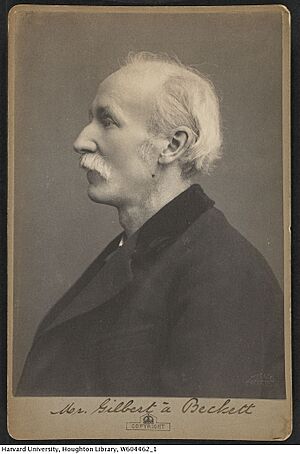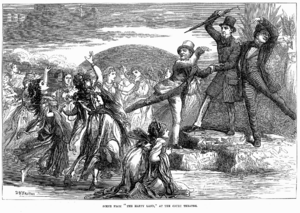Gilbert Arthur à Beckett facts for kids
Gilbert Arthur à Beckett (born April 7, 1837 – died October 15, 1891) was an English writer. He was known for his plays, operettas, and his work for the famous Punch magazine.
Contents
Life and Work
Early Life and Education
Gilbert Arthur à Beckett was born in Hammersmith, London, on April 7, 1837. His father, Gilbert Abbott à Beckett, was a civil servant and humorist. His mother, Mary Anne à Beckett, was a composer. Gilbert was the oldest son in the family. His brother was Arthur William à Beckett, who also became a writer.
Gilbert studied at Christ Church in Oxford. He graduated from there in 1860. He also began studying law in 1857. However, he soon focused more on writing for the stage.
Plays and Operettas
Gilbert à Beckett wrote many plays and musical shows. In 1867, his play Diamonds and Hearts was shown at the Haymarket Theatre. He wrote other light comedies as well.
In 1868, his show The Two Harlequins helped open the new Gaiety Theatre, London. This show was based on a French operetta. It opened alongside a play by his distant cousin, W. S. Gilbert.
He also wrote many burlesques and pantomimes. These were funny plays that made fun of serious topics or stories. He wrote the words (libretti) for two operas: Savonarola (1884) and The Canterbury Pilgrims (1884). Both had music by Dr. C. V. Stanford. With composer Alfred Cellier, he wrote the operetta Two Foster Brothers in 1877.
Working for Punch Magazine
In 1879, Gilbert à Beckett joined the staff of Punch magazine. Punch was a very popular British humor magazine. Three years later, he became a regular member of the team. He loved the Punch dinners. Even though he had trouble walking due to leg paralysis, he always tried to attend.
He wrote both funny stories and poems for Punch. He created a funny fake advertisement section called 'How we advertise now.' He also came up with the idea for one of Punch's most famous cartoons. This cartoon was called 'Dropping the Pilot' (1889). It showed Otto von Bismarck, a powerful German leader, leaving his job.
Other Notable Works
Besides his work for Punch, Gilbert à Beckett wrote songs and music for other shows. In 1873, he helped create a play called The Happy Land.
The Happy Land was a political satire. It made fun of three important British politicians: William Gladstone, Robert Lowe, and Acton Smee Ayrton. The actors dressed up to look like these politicians. This caused a stir in the House of Commons. The Lord Chamberlain, who was in charge of theaters, visited the play. As a result, the actors had to change their costumes to look less like the real politicians.
In 1874, he wrote the story for a play called 'The White Pilgrim.' Near the end of his life, he wrote the words for the operetta La Cigale. This show was very popular and had almost 400 performances.
Later Life and Death
In 1889, Gilbert à Beckett faced a sad event when his only son died by drowning. He himself passed away in London on October 15, 1891. He was buried in Mortlake cemetery.
Legacy
Punch magazine wrote a poem in his memory, praising his life. His picture appeared in a well-known drawing called 'The Mahogany Tree' in Punch (1887). Other pictures of him were also published in the 'Illustrated London News' and in a book about the history of Punch.
Family
Gilbert à Beckett married Emily Hunt. She was the oldest daughter of William Hunt. His only daughter, Minna, married Mr. Hugh Clifford in 1896. Hugh Clifford later became a governor in British North Borneo.
See also
 In Spanish: Gilbert Arthur à Beckett para niños
In Spanish: Gilbert Arthur à Beckett para niños



